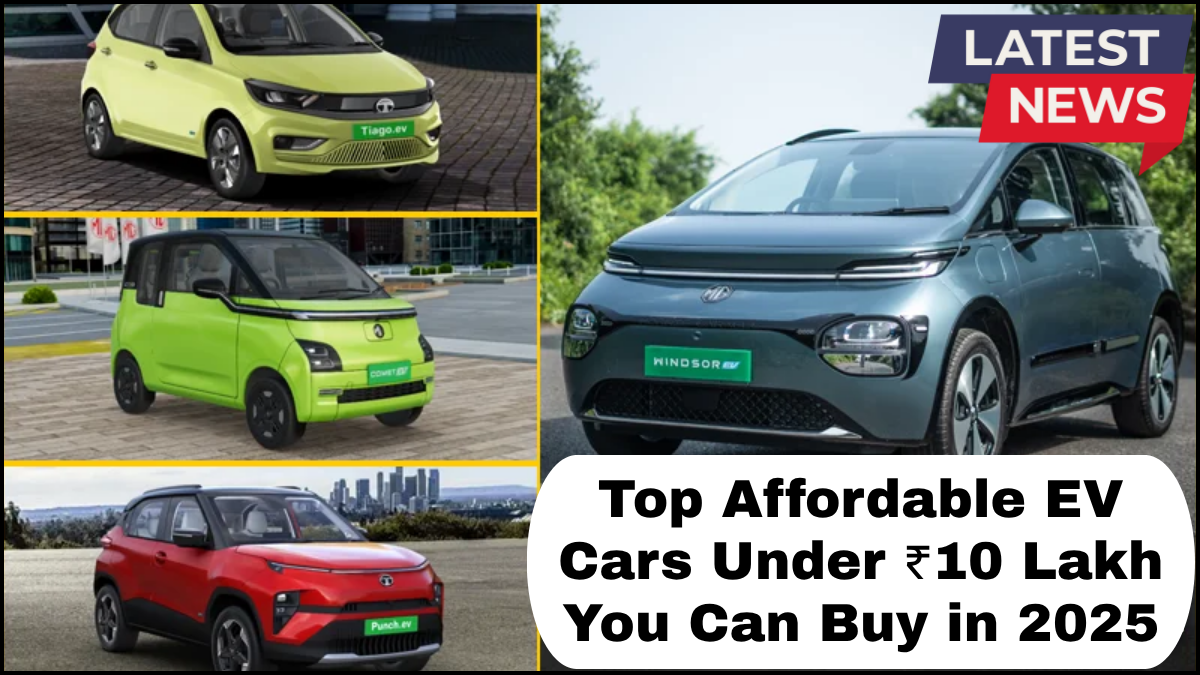The electric vehicle (EV) revolution in India is gathering serious momentum. With rising fuel costs, increasing environmental awareness, and major policy pushes toward clean mobility, 2025 is set to be a pivotal year for EV adoption. What’s even more exciting? The wave of budget EV trends under ₹10 lakh that are making electric mobility accessible to the average Indian buyer.

If you’re planning to switch to an EV without burning a hole in your pocket, here’s a detailed guide to the top affordable electric cars you can actually buy in 2025 – all under ₹10 lakh.
1. Tata Tiago EV – The Most Practical Entry-Level Option
The Tata Tiago EV remains a favorite in the budget EV segment. With a starting price well under ₹10 lakh for the base variant, it’s a solid choice for city commuting.
-
Battery & Range: Offers two battery options – 19.2 kWh and 24 kWh – delivering ranges between 250 to 315 km.
-
Charging: Fast charging support, up to 80% in just over an hour.
-
Performance: Decent torque and a smooth automatic transmission make it easy to drive in urban traffic.
The Tiago EV’s proven safety record, familiar design, and Tata’s wide service network make it one of the most affordable electric cars worth considering.
2. MG Comet EV – Compact, Connected, and Cost-Effective
If you’re looking for an ultra-compact urban EV, the MG Comet brings smart features and futuristic design in a price bracket close to ₹8 lakh.
-
Battery & Range: 17.3 kWh battery with an ARAI-claimed range of around 230 km.
-
Tech Features: 10.25-inch touchscreen, voice commands, smart connectivity.
-
Use Case: Ideal for city drives, tight parking spaces, and daily errands.
Its compact dimensions make it perfect for congested urban environments, aligning perfectly with budget EV trends under ₹10 lakh.
3. PMV EaS-E – India’s Cheapest Electric Microcar
The PMV EaS-E, priced around ₹4-5 lakh, is designed to be India’s most accessible electric car. While technically a quadricycle, it’s gaining traction as a last-mile urban mobility solution.
-
Battery & Range: Offers up to 200 km of range on a full charge.
-
Design: Two-door, one-seater with minimalist interiors.
-
Purpose: Designed for short commutes and low-speed travel.
This ultra-affordable model is a good entry point for those hesitant about EV costs but looking to get into the green mobility space.
4. Mahindra e2o Plus (Expected Relaunch)
While the Mahindra e2o Plus was discontinued earlier, there are strong rumors about a 2025 relaunch with updated tech and compliance.
-
Battery & Range (Expected): Around 20 kWh battery with a 200–250 km range.
-
Price: Likely to be under ₹9 lakh.
-
Urban Utility: Compact size, easy maneuverability, and improved interiors.
Its revival would give Mahindra a presence in the affordable electric cars category again, meeting demand from first-time EV buyers.
5. Strom R3 – Futuristic and Fully Made in India
The Strom R3, a three-wheeled electric car developed in India, is aimed at tech-savvy urbanites.
-
Price Tag: Expected to be priced at ₹4.5 lakh (ex-showroom).
-
Design & Features: Sci-fi looks, digital displays, remote diagnostics.
-
Range: Claimed 200 km per charge with minimal charging cost.
Despite its unconventional design, the R3 offers one of the lowest running costs and is a strong contender in the budget EV trends under ₹10 lakh segment.
What Makes Budget EVs in 2025 More Appealing?
-
Government Subsidies: Central and state-level FAME II subsidies significantly reduce on-road prices.
-
Lower Running Costs: Compared to petrol/diesel, EVs offer much cheaper per km costs.
-
Urban Suitability: Most budget EVs are optimized for city driving, with compact footprints and sufficient range.
-
Financing & EMI Plans: Many automakers offer attractive zero-down-payment or low-interest EMI options for budget-conscious buyers.
-
Improved Charging Infrastructure: Cities are rapidly expanding EV charging networks, making ownership easier than ever.
Things to Consider Before Buying a Budget EV
-
Range Requirements: Choose a car that meets your daily driving needs.
-
Charging Accessibility: Check the availability of chargers in your locality or install a home charger.
-
Maintenance & Warranty: Go with brands that offer clear service policies and battery warranties.
-
Real-World Reviews: Always consider user experiences, not just company claims.
FAQs: Budget EV Trends Under ₹10 Lakh
Q1: Can I buy a reliable electric car under ₹10 lakh in 2025?
A: Absolutely. With options like the Tata Tiago EV and MG Comet, you can find reliable, feature-packed electric cars well within a ₹10 lakh budget.
Q2: Are budget EVs suitable for long drives?
A: Not ideally. Most budget EVs are designed for city use and short commutes. Their range typically caps around 200–300 km.
Q3: How much can I save with an electric car vs. petrol?
A: On average, EVs can save you ₹1–1.5 per km in fuel costs. Over five years, this could mean ₹1–2 lakh in savings, depending on your usage.
Q4: Is battery replacement costly for these EVs?
A: Yes, but most manufacturers offer 5–8 years of battery warranty. After that, replacement costs could range from ₹1.5 to ₹3 lakh depending on the model.
Q5: Are there enough charging stations in India for EVs?
A: Charging infrastructure is growing fast, especially in Tier 1 and Tier 2 cities. Brands also support home charging setups for convenience.
click here to learn more
